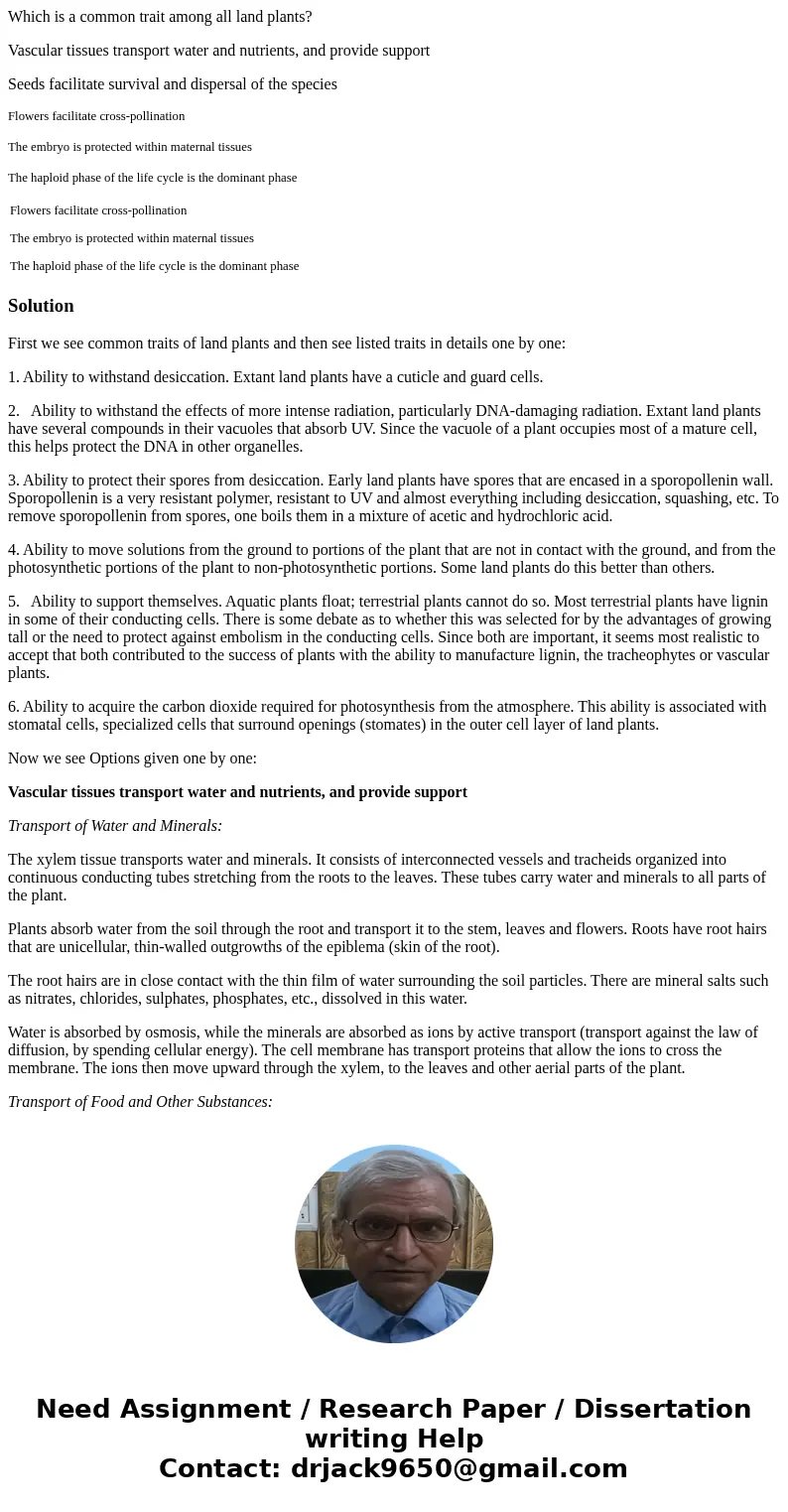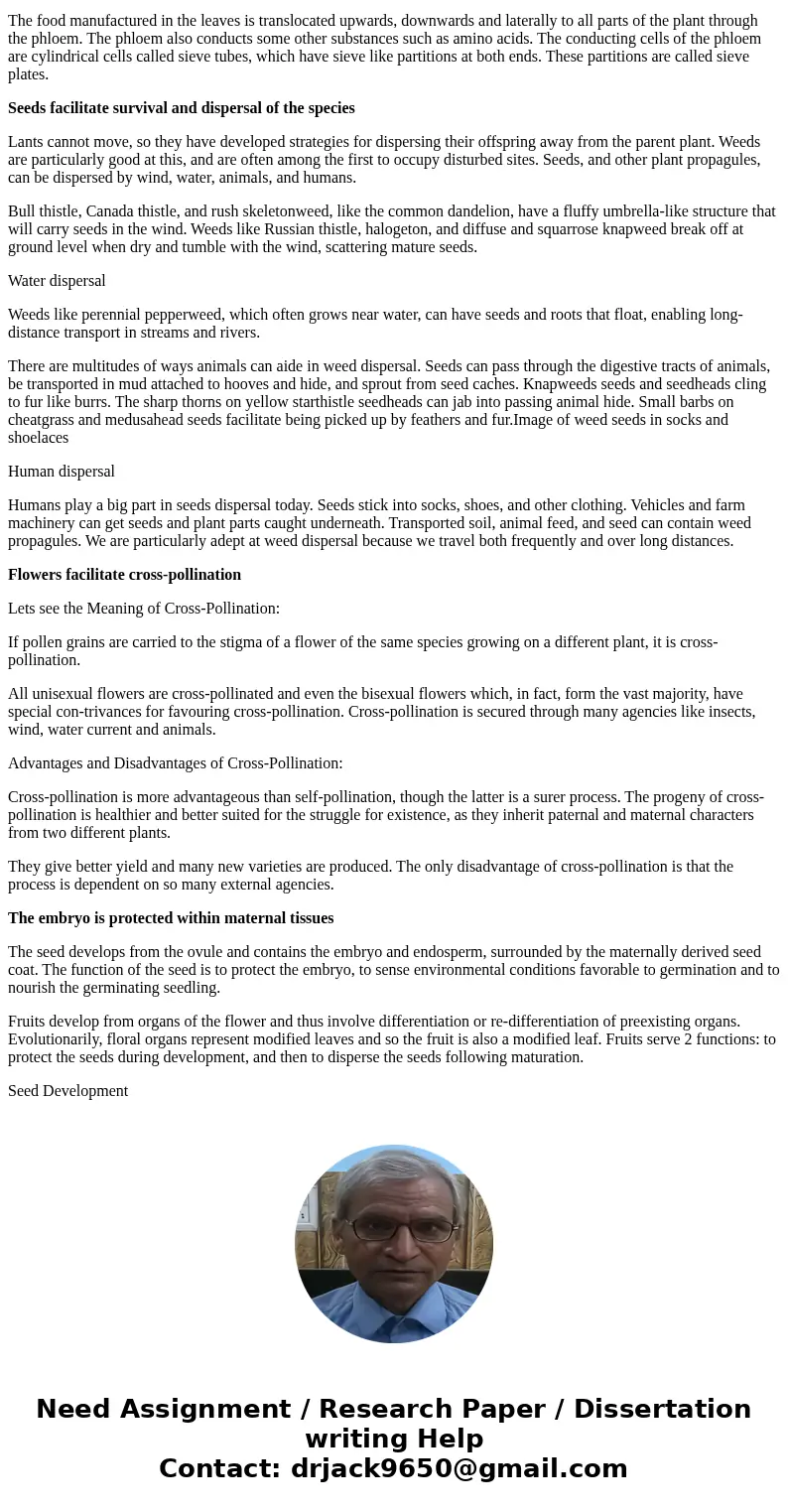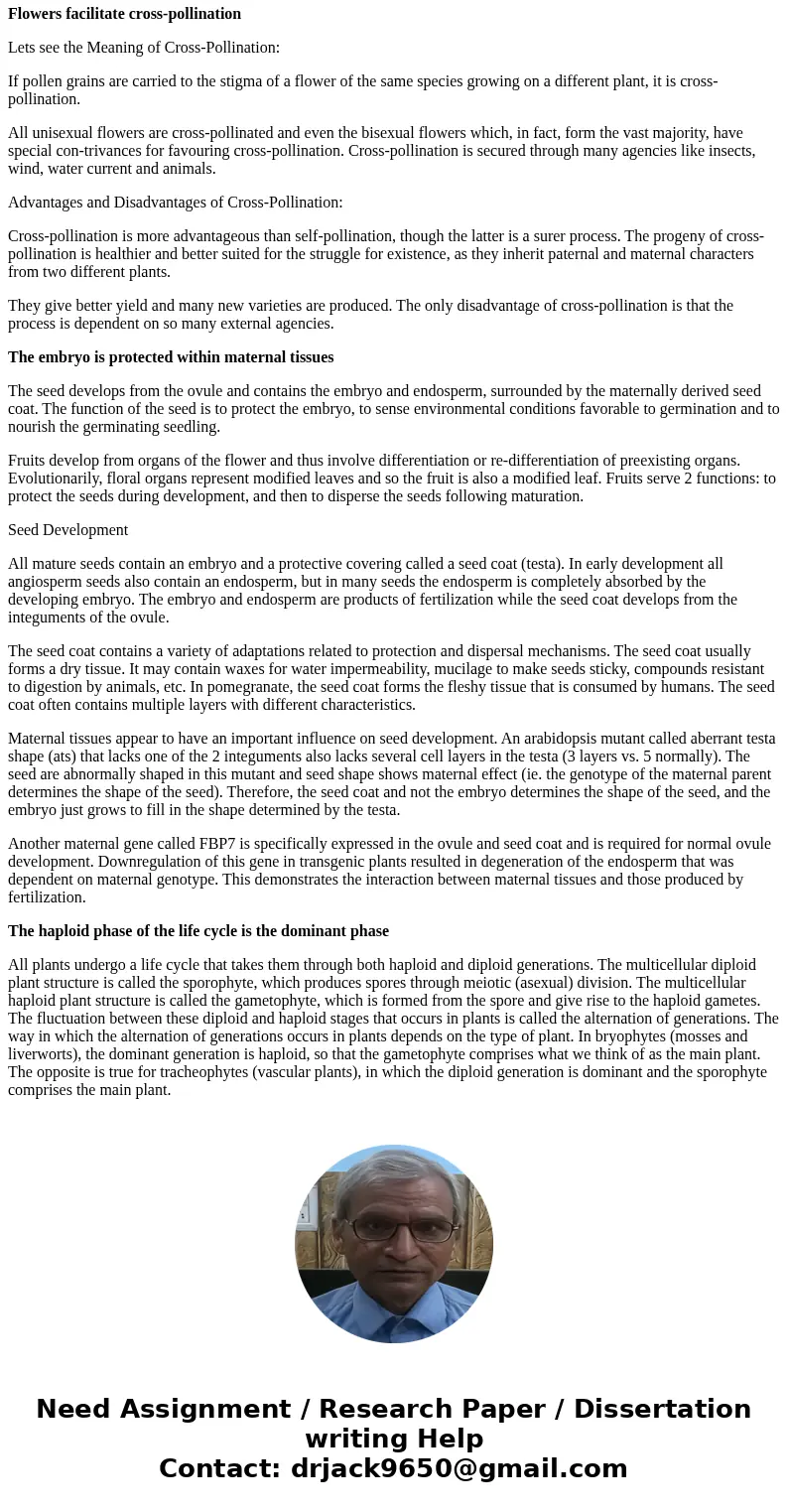Which is a common trait among all land plants Vascular tissu
Which is a common trait among all land plants?
Vascular tissues transport water and nutrients, and provide support
Seeds facilitate survival and dispersal of the species
Flowers facilitate cross-pollination
The embryo is protected within maternal tissues
The haploid phase of the life cycle is the dominant phase
| Flowers facilitate cross-pollination The embryo is protected within maternal tissues The haploid phase of the life cycle is the dominant phase |
Solution
First we see common traits of land plants and then see listed traits in details one by one:
1. Ability to withstand desiccation. Extant land plants have a cuticle and guard cells.
2. Ability to withstand the effects of more intense radiation, particularly DNA-damaging radiation. Extant land plants have several compounds in their vacuoles that absorb UV. Since the vacuole of a plant occupies most of a mature cell, this helps protect the DNA in other organelles.
3. Ability to protect their spores from desiccation. Early land plants have spores that are encased in a sporopollenin wall. Sporopollenin is a very resistant polymer, resistant to UV and almost everything including desiccation, squashing, etc. To remove sporopollenin from spores, one boils them in a mixture of acetic and hydrochloric acid.
4. Ability to move solutions from the ground to portions of the plant that are not in contact with the ground, and from the photosynthetic portions of the plant to non-photosynthetic portions. Some land plants do this better than others.
5. Ability to support themselves. Aquatic plants float; terrestrial plants cannot do so. Most terrestrial plants have lignin in some of their conducting cells. There is some debate as to whether this was selected for by the advantages of growing tall or the need to protect against embolism in the conducting cells. Since both are important, it seems most realistic to accept that both contributed to the success of plants with the ability to manufacture lignin, the tracheophytes or vascular plants.
6. Ability to acquire the carbon dioxide required for photosynthesis from the atmosphere. This ability is associated with stomatal cells, specialized cells that surround openings (stomates) in the outer cell layer of land plants.
Now we see Options given one by one:
Vascular tissues transport water and nutrients, and provide support
Transport of Water and Minerals:
The xylem tissue transports water and minerals. It consists of interconnected vessels and tracheids organized into continuous conducting tubes stretching from the roots to the leaves. These tubes carry water and minerals to all parts of the plant.
Plants absorb water from the soil through the root and transport it to the stem, leaves and flowers. Roots have root hairs that are unicellular, thin-walled outgrowths of the epiblema (skin of the root).
The root hairs are in close contact with the thin film of water surrounding the soil particles. There are mineral salts such as nitrates, chlorides, sulphates, phosphates, etc., dissolved in this water.
Water is absorbed by osmosis, while the minerals are absorbed as ions by active transport (transport against the law of diffusion, by spending cellular energy). The cell membrane has transport proteins that allow the ions to cross the membrane. The ions then move upward through the xylem, to the leaves and other aerial parts of the plant.
Transport of Food and Other Substances:
The food manufactured in the leaves is translocated upwards, downwards and laterally to all parts of the plant through the phloem. The phloem also conducts some other substances such as amino acids. The conducting cells of the phloem are cylindrical cells called sieve tubes, which have sieve like partitions at both ends. These partitions are called sieve plates.
Seeds facilitate survival and dispersal of the species
Lants cannot move, so they have developed strategies for dispersing their offspring away from the parent plant. Weeds are particularly good at this, and are often among the first to occupy disturbed sites. Seeds, and other plant propagules, can be dispersed by wind, water, animals, and humans.
Bull thistle, Canada thistle, and rush skeletonweed, like the common dandelion, have a fluffy umbrella-like structure that will carry seeds in the wind. Weeds like Russian thistle, halogeton, and diffuse and squarrose knapweed break off at ground level when dry and tumble with the wind, scattering mature seeds.
Water dispersal
Weeds like perennial pepperweed, which often grows near water, can have seeds and roots that float, enabling long-distance transport in streams and rivers.
There are multitudes of ways animals can aide in weed dispersal. Seeds can pass through the digestive tracts of animals, be transported in mud attached to hooves and hide, and sprout from seed caches. Knapweeds seeds and seedheads cling to fur like burrs. The sharp thorns on yellow starthistle seedheads can jab into passing animal hide. Small barbs on cheatgrass and medusahead seeds facilitate being picked up by feathers and fur.Image of weed seeds in socks and shoelaces
Human dispersal
Humans play a big part in seeds dispersal today. Seeds stick into socks, shoes, and other clothing. Vehicles and farm machinery can get seeds and plant parts caught underneath. Transported soil, animal feed, and seed can contain weed propagules. We are particularly adept at weed dispersal because we travel both frequently and over long distances.
Flowers facilitate cross-pollination
Lets see the Meaning of Cross-Pollination:
If pollen grains are carried to the stigma of a flower of the same species growing on a different plant, it is cross-pollination.
All unisexual flowers are cross-pollinated and even the bisexual flowers which, in fact, form the vast majority, have special con-trivances for favouring cross-pollination. Cross-pollination is secured through many agencies like insects, wind, water current and animals.
Advantages and Disadvantages of Cross-Pollination:
Cross-pollination is more advantageous than self-pollination, though the latter is a surer process. The progeny of cross-pollination is healthier and better suited for the struggle for existence, as they inherit paternal and maternal characters from two different plants.
They give better yield and many new varieties are produced. The only disadvantage of cross-pollination is that the process is dependent on so many external agencies.
The embryo is protected within maternal tissues
The seed develops from the ovule and contains the embryo and endosperm, surrounded by the maternally derived seed coat. The function of the seed is to protect the embryo, to sense environmental conditions favorable to germination and to nourish the germinating seedling.
Fruits develop from organs of the flower and thus involve differentiation or re-differentiation of preexisting organs. Evolutionarily, floral organs represent modified leaves and so the fruit is also a modified leaf. Fruits serve 2 functions: to protect the seeds during development, and then to disperse the seeds following maturation.
Seed Development
All mature seeds contain an embryo and a protective covering called a seed coat (testa). In early development all angiosperm seeds also contain an endosperm, but in many seeds the endosperm is completely absorbed by the developing embryo. The embryo and endosperm are products of fertilization while the seed coat develops from the integuments of the ovule.
The seed coat contains a variety of adaptations related to protection and dispersal mechanisms. The seed coat usually forms a dry tissue. It may contain waxes for water impermeability, mucilage to make seeds sticky, compounds resistant to digestion by animals, etc. In pomegranate, the seed coat forms the fleshy tissue that is consumed by humans. The seed coat often contains multiple layers with different characteristics.
Maternal tissues appear to have an important influence on seed development. An arabidopsis mutant called aberrant testa shape (ats) that lacks one of the 2 integuments also lacks several cell layers in the testa (3 layers vs. 5 normally). The seed are abnormally shaped in this mutant and seed shape shows maternal effect (ie. the genotype of the maternal parent determines the shape of the seed). Therefore, the seed coat and not the embryo determines the shape of the seed, and the embryo just grows to fill in the shape determined by the testa.
Another maternal gene called FBP7 is specifically expressed in the ovule and seed coat and is required for normal ovule development. Downregulation of this gene in transgenic plants resulted in degeneration of the endosperm that was dependent on maternal genotype. This demonstrates the interaction between maternal tissues and those produced by fertilization.
The haploid phase of the life cycle is the dominant phase
All plants undergo a life cycle that takes them through both haploid and diploid generations. The multicellular diploid plant structure is called the sporophyte, which produces spores through meiotic (asexual) division. The multicellular haploid plant structure is called the gametophyte, which is formed from the spore and give rise to the haploid gametes. The fluctuation between these diploid and haploid stages that occurs in plants is called the alternation of generations. The way in which the alternation of generations occurs in plants depends on the type of plant. In bryophytes (mosses and liverworts), the dominant generation is haploid, so that the gametophyte comprises what we think of as the main plant. The opposite is true for tracheophytes (vascular plants), in which the diploid generation is dominant and the sporophyte comprises the main plant.



 Homework Sourse
Homework Sourse